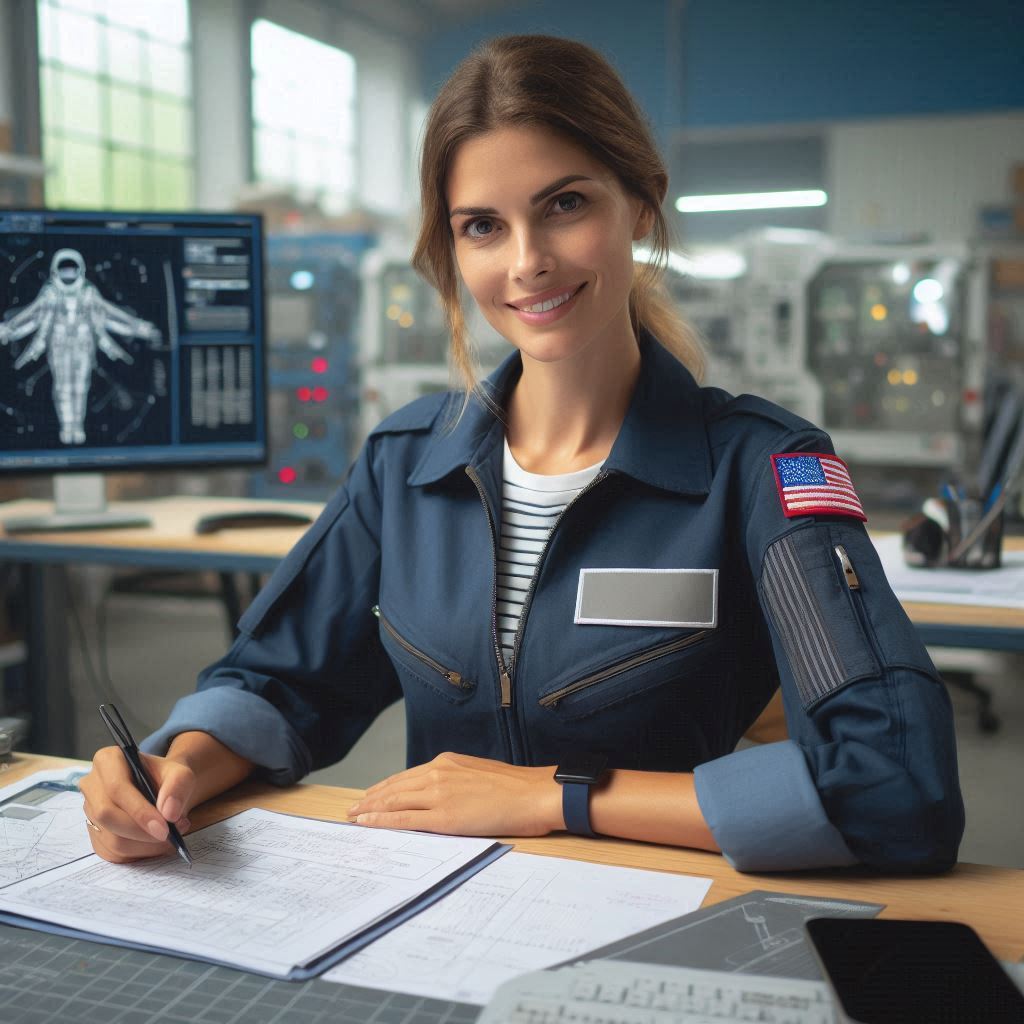Introduction
Today, aerospace engineers play a crucial role in shaping the future of air and space travel.
As technology advances, so do the challenges that these professionals face.
Overview of the aerospace engineering industry
The aerospace engineering industry is a dynamic field that encompasses the design, development, and testing of aircraft and spacecraft.
Aerospace engineers work on a wide range of projects, from commercial airlines to military defense systems.
Importance of aerospace engineers in today’s society
Aerospace engineers are essential for ensuring the safety and efficiency of air travel, as well as for advancing research in space exploration.
Their work has a direct impact on our daily lives, from the way we fly to the technologies we use.
Challenges facing aerospace engineers today
One of the main challenges facing aerospace engineers today is the rapid pace of technological advancement.
Keeping up with the latest developments in materials, software, and systems can be a daunting task.
Another challenge is ensuring the safety and reliability of aircraft and spacecraft.
Aerospace engineers must constantly innovate and improve designs to meet stringent safety standards and regulations.
Additionally, the growing demand for sustainable aerospace solutions poses a challenge for engineers.
Developing environmentally-friendly aircraft and reducing carbon emissions is a priority in the industry.
Furthermore, global competition and economic pressures put pressure on aerospace engineers to deliver projects on time and within budget.
This requires careful planning, coordination, and efficient resource management.
Therefore, aerospace engineers face a variety of challenges in today’s rapidly evolving industry.
By addressing these challenges head-on, they can continue to drive innovation and shape the future of aviation and space exploration.
Read: Freelance vs. Firm: Career Paths for US Architects
Rapid Technological Advancements
Aerospace engineers today face the challenge of keeping up with rapid technological advancements.
With new technologies emerging constantly, they must stay updated to remain competitive in the industry.
Aerospace engineers need to adapt to using advanced materials like composites and alloys for building aircraft.
Additive manufacturing techniques, such as 3D printing, are also becoming more prevalent.
Integrating digital technologies
The integration of digital technologies like artificial intelligence and machine learning is crucial for improving the performance and efficiency of aerospace systems.
Increasing Competition in the Industry
The aerospace industry is becoming increasingly competitive, with more companies entering the market and offering innovative solutions.
Aerospace engineers must find ways to differentiate themselves and their products to stay ahead.
Global competition
Aerospace engineers face competition from around the world, as companies in different countries strive to become leaders in the industry.
Start-ups disrupting traditional aerospace companies
Start-up companies are disrupting the aerospace industry with new ideas and technologies.
Aerospace engineers need to be agile and adaptable to keep up with these changes.
Balancing Innovation with Safety and Regulation
Aerospace engineers must strike a delicate balance between pushing the boundaries of innovation and ensuring the safety and compliance of their designs with regulations.
Stringent safety standards
Meeting stringent safety standards is paramount in the aerospace industry to prevent accidents and ensure the reliability of aircraft systems.
Adhering to regulatory requirements
Aerospace engineers must adhere to various regulatory requirements imposed by aviation authorities to ensure the airworthiness of aircraft.
Limited Resources and Funding for Research and Development
Despite the importance of research and development in the aerospace industry, engineers face challenges due to limited resources and funding constraints.
Cost constraints
Developing new technologies and innovations in aerospace can be costly, and engineers must work within budget constraints to achieve their goals.
Transform Your Career Today
Unlock a personalized career strategy that drives real results. Get tailored advice and a roadmap designed just for you.
Start NowRisk of project delays
Limited resources can lead to project delays, hindering the progress of research and development initiatives in the aerospace sector.
Basically, aerospace engineers today face significant challenges, from adapting to rapid technological advancements to navigating increased competition in the industry.
Balancing innovation with safety and compliance, as well as overcoming limited resources and funding constraints, require engineers to be resilient and adaptable in the ever-evolving aerospace landscape.
Read: The Intersection: Architecture & Tech in Modern USA.
Impact of Global Events and Political Instability on the Aerospace Industry
Environmental Concerns and the Push for Sustainable Aviation
Aerospace engineers face increasing pressure to develop sustainable aviation technologies.
The aviation industry significantly contributes to carbon emissions.
Engineers must innovate to reduce the environmental impact of air travel.
Developing fuel-efficient engines and lightweight materials are critical tasks.
Biofuels and electric propulsion systems present promising solutions.
Engineers are working on improving the efficiency of these technologies.
The industry demands faster progress towards carbon-neutral aviation.
Regulatory bodies and environmental organizations push for stringent emissions standards.
The shift towards sustainability requires substantial investment and research.
Engineers must balance environmental goals with economic feasibility.
This challenge demands creative solutions and collaboration across the industry.
The push for sustainable aviation is reshaping the future of aerospace engineering.
Lack of Diversity and Inclusion in the Field
The aerospace industry struggles with diversity and inclusion.
Women and minorities are underrepresented in aerospace engineering roles.
This lack of diversity limits innovation and growth.
Inclusive teams bring diverse perspectives and ideas, driving better solutions.
Efforts to promote diversity are gaining momentum.
Companies are implementing programs to attract and retain diverse talent.
Scholarships and mentorship programs aim to support underrepresented groups.
Despite these efforts, progress is slow and inconsistent.
Cultural and systemic barriers hinder diversity in aerospace engineering.
Addressing these barriers requires commitment from industry leaders.
Creating an inclusive environment is essential for fostering innovation.
Engineers must advocate for diversity and inclusion within their organizations.
Inclusive policies and practices benefit the entire industry.
They enhance team dynamics and lead to more innovative solutions.
Embracing diversity is crucial for the future of aerospace engineering.
Engineers must champion these efforts to create lasting change.
Mental Health Issues and Burnout Among Aerospace Engineers
Aerospace engineers face significant stress and high demands.
The industry‘s fast-paced nature can lead to mental health issues and burnout.
Engineers often work long hours under intense pressure.
This can result in chronic stress, anxiety, and depression.
Burnout is a common issue among aerospace professionals.
It affects productivity, creativity, and overall well-being.
Addressing mental health in the workplace is critical.
Companies are beginning to recognize the importance of mental health support.
Providing resources and support for mental health is essential.
Employee assistance programs and counseling services can help.
Promoting work-life balance and flexible schedules reduces stress.
Engineers should feel encouraged to seek help when needed.
Creating a supportive work environment improves mental health outcomes.
Open conversations about mental health reduce stigma and encourage support.
Leadership plays a key role in fostering a healthy workplace culture.
Engineers must prioritize their well-being to sustain long-term career success.
In general, aerospace engineers face significant challenges today.
Environmental concerns drive the push for sustainable aviation.
The industry must address the lack of diversity and inclusion.
Mental health issues and burnout are prevalent and need attention.
Overcoming these challenges requires collaboration, innovation, and a commitment to change.
By addressing these issues, aerospace engineering can continue to thrive and evolve.
Read: Post-Pandemic Design Trends: US Architects Adapt

Uncover the Details: Day in the Life of an Automotive Engineer
Overcoming challenges through collaboration and partnerships
Investing in Continuous Education and Professional Development
Aerospace engineers face rapid technological advancements.
Investing in continuous education ensures they stay ahead.
Engineers must regularly update their knowledge and skills.
This involves pursuing advanced degrees, attending workshops, and obtaining certifications.
Many companies offer tuition reimbursement programs to support further education.
Online courses and webinars provide flexible learning options.
Engineers can also join professional organizations like AIAA for networking and resources.
Mentorship programs play a crucial role in professional development.
Experienced engineers guide newcomers, sharing insights and expertise.
These relationships foster growth and knowledge transfer.
Additionally, rotational programs expose engineers to various roles and projects.
This broadens their experience and enhances versatility.
By committing to lifelong learning, aerospace engineers can adapt to new challenges and opportunities.
Implementing Strict Safety Protocols and Regulations
Safety is paramount in aerospace engineering.
Engineers must adhere to strict protocols and regulations.
These measures ensure the reliability and safety of aircraft and spacecraft.
Regular inspections and maintenance checks are crucial.
Engineers conduct rigorous testing to identify potential issues.
They must follow guidelines set by regulatory bodies like FAA and EASA.
Transform Your Career Today
Unlock a personalized career strategy that drives real results. Get tailored advice and a roadmap designed just for you.
Start NowQuality assurance plays a vital role in maintaining safety standards.
Engineers must document every step of the design and manufacturing process.
This transparency allows for thorough reviews and audits.
Incident reports and data analysis help identify recurring problems.
Engineers can then develop solutions to prevent future issues.
Training is essential for ensuring compliance with safety protocols.
Engineers undergo regular safety training and simulations.
These sessions prepare them for emergency situations and enhance their problem-solving skills.
By prioritizing safety, aerospace engineers protect passengers, crew, and equipment.
Sustainability Initiatives and Green Engineering Practices
Sustainability is a growing concern in aerospace engineering.
Engineers are developing green technologies to reduce environmental impact.
This includes designing more fuel-efficient aircraft and exploring alternative fuels.
Electrification is another key focus, with engineers working on electric propulsion systems.
These innovations aim to lower carbon emissions and conserve resources.
Recycling and waste reduction are also important aspects of sustainability.
Engineers use lightweight, recyclable materials in aircraft construction.
This reduces fuel consumption and minimizes waste.
Sustainable manufacturing processes further enhance efficiency.
For instance, 3D printing reduces material waste and energy usage.
Collaboration with environmental organizations helps engineers adopt best practices.
Companies partner with groups like IATA to develop sustainability guidelines.
Engineers participate in research and development projects focused on green technologies.
These initiatives drive progress towards a more sustainable aerospace industry.
Public awareness and education are crucial for promoting sustainability.
Engineers engage with communities to highlight the importance of green practices.
They participate in conferences and publish research on sustainable innovations.
By leading these efforts, aerospace engineers contribute to a healthier planet.
Read: Top Cities for Electrical Engineering Jobs in America
Conclusion
Summary of Key Challenges Facing Aerospace Engineers
Aerospace engineers face challenges such as rapid technological advancements.
These advancements require engineers to constantly update their skills.
Budget constraints can also hinder the development of new aerospace technologies.
Environmental concerns, such as emissions and fuel efficiency, are another challenge.
Global competition in the aerospace industry makes innovation crucial for success.
Regulatory requirements and safety standards add complexity to aerospace engineering projects.
Importance of Addressing These Challenges
Addressing these challenges is paramount for the future of the aerospace industry.
Failure to adapt to new technologies and regulations can result in obsolescence.
Innovations in aerospace engineering can lead to more efficient and sustainable aircraft.
Solving these challenges will ensure the industry remains competitive and relevant.
By overcoming these obstacles, aerospace engineers can drive progress and advancement.
Encouragement for Aerospace Engineers
Aerospace engineers must adapt, innovate, and overcome challenges to succeed.
Continuous learning and skill development are essential for staying competitive.
Collaboration with experts from different fields can lead to breakthrough innovations.
Embracing change and taking risks can result in groundbreaking advancements.
Aerospace engineers play a vital role in shaping the future of air travel.
[E-Books for Sale]
The Big Book of 500 High-Paying Jobs in America: Unlock Your Earning Potential
$19.99 • 500 High-Paying Jobs • 330 pages
Explore 500 high-paying jobs in America and learn how to boost your career, earn more, and achieve success!
See All 500 High-Paying Jobs of this E-Book
1001 Professions Without a Degree: High-Paying American Jobs You Can Start Now
$19.99 • 1001 Professions Without a Degree • 174 pages
Discover 1001 high-paying jobs without a degree! Unlock career tips, skills, and success strategies for just $19.99!




